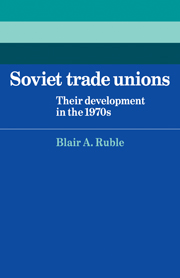Book contents
- Frontmatter
- Contents
- List of tables and figures
- Acknowledgments
- Abbreviations
- Introduction
- 1 Soviet trade union development: 1917–1956
- 2 Soviet trade union development: 1957–1980
- 3 Union–management–Party relations at the plant
- 4 The legal and social rights of Soviet workers
- 5 Do workers participate in Soviet management?
- 6 Patterns of union behavior
- 7 The international activities of Soviet trade unions
- Conclusion
- Notes
- Classified bibliography
- Index
7 - The international activities of Soviet trade unions
Published online by Cambridge University Press: 07 October 2011
- Frontmatter
- Contents
- List of tables and figures
- Acknowledgments
- Abbreviations
- Introduction
- 1 Soviet trade union development: 1917–1956
- 2 Soviet trade union development: 1957–1980
- 3 Union–management–Party relations at the plant
- 4 The legal and social rights of Soviet workers
- 5 Do workers participate in Soviet management?
- 6 Patterns of union behavior
- 7 The international activities of Soviet trade unions
- Conclusion
- Notes
- Classified bibliography
- Index
Summary
International efforts to create workingmen's solidarity anticipate Russian unionism by several decades. As a result, when the Bolsheviks attempted to participate in these efforts, they found themselves moving into a world they had done little to create. Moreover, the newly legitimized Russian labor politicians suddenly had opponents whose working-class credentials were at least as solid as those of Moscow.
The concept of labor solidarity dates from the founding of the First International by Karl Marx in 1864. Doctrinal squabbles led to the demise of that body, and a quarter of a century later, the Second (or Socialist) International came into being. In the meantime, several independent efforts to foster union cooperation were underway. The 1890s witnessed the birth of the International Trade Secretariats (ITS), organizations which represent individual unions in similar industries from around the world. Then in 1903 the International Secretariat of National Trade Union Centers developed as the economic arm of the Second International. In spite of Samuel Gompers's opposition to the International's socialist convictions, the American Federation of Labor (AFL) joined its union arm, which was then known as the International Federation of Trade Unions (IFTU), in 1909. As Europe headed to war, the IFTU appeared to be moving toward universal trade union unity.
IFTU members supported the tradition that only one union center could be admitted from any one country. Therefore, powerful Czech unions were preempted from joining by their Austrian counterparts, as were many important non-AFL labor groups from North America.
- Type
- Chapter
- Information
- Soviet Trade UnionsTheir Development in the 1970s, pp. 119 - 138Publisher: Cambridge University PressPrint publication year: 1981



